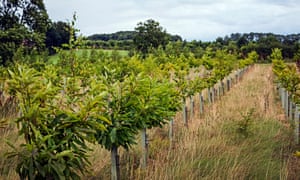Nature-based solutions to the climate crisis must work with vulnerable communities, not leave them to pick up the bill
A new study extols the “mindblowing” potential
of widespread tree planting as a solution to climate breakdown. The
scientists claim that 1bn hectares of treeless land could be forested –
an area equivalent to the size of the US – and the study’s authors say
restoration of such areas could remove two-thirds (205 gigatonnes) of all the carbon dioxide emissions pumped into the atmosphere by human activities since the 1800s.
A number of organisations and scientists are investigating these nature-based climate solutions. While studies show different levels of ambition and potential, all are clear that carefully restored ecosystems can help solve three interlinked crises: the climate crisis, biodiversity loss and poverty. For climate, the most urgent priority to meet the goal of keeping global heating below 1.5C is decarbonising the economy, but restoring our forests, grasslands and wetlands, plus enhancing soil health, could provide part of the solution to the climate crisis. Land restoration and stewardship can both help stabilise the Earth’s climate by storing carbon, and provide ecosystems critical for wildlife – forests, mangroves, wetlands and coral reefs. This can also benefit local communities, particularly in emerging regions of the global south least responsible for this crisis and already suffering most severely from the impacts.
Science must inform the “guardrails” for solutions, demonstrating
what is socially and environmentally possible while ensuring vulnerable
people do not pay the bill and natural ecosystems are not put in further
peril. Now we need to go beyond the numbers. Examining nature-based
solutions, such as afforestation, means also putting people in the picture. The recent UN biodiversity study
made it clear that Indigenous peoples and issues of land tenure are
central to addressing biodiversity loss. Last week’s study on the
possibilities of mass tree planting, led by Tom Crowther
at the Swiss university ETH Zürich, explicitly does not go into
questions of ownership. Its computer model does not include land rights
issues, which then puts into question the notion that more than 1bn
hectares of tree cover is “undoubtedly achievable under the current climate”.A number of organisations and scientists are investigating these nature-based climate solutions. While studies show different levels of ambition and potential, all are clear that carefully restored ecosystems can help solve three interlinked crises: the climate crisis, biodiversity loss and poverty. For climate, the most urgent priority to meet the goal of keeping global heating below 1.5C is decarbonising the economy, but restoring our forests, grasslands and wetlands, plus enhancing soil health, could provide part of the solution to the climate crisis. Land restoration and stewardship can both help stabilise the Earth’s climate by storing carbon, and provide ecosystems critical for wildlife – forests, mangroves, wetlands and coral reefs. This can also benefit local communities, particularly in emerging regions of the global south least responsible for this crisis and already suffering most severely from the impacts.
Debates about the numbers – the sequestration potential of trees or any other solution – are not abstract mathematical games. They are the politics of the climate crisis, shaping who is burdened with the responsibility of change and who faces the risks of inaction. Done badly, benign-sounding tree planting schemes can simply be photo ops, shady offsetting schemes or even land grabs. Supporting environmental defenders and resisting dodgy cows-for-cars trade deals may be just as important as the technical efforts of forest managers. Where relevant, Indigenous peoples’ stewardship is the most effective means of keeping forest and soil carbon locked up, climate-resilient and biodiverse – but these people face the greatest risks and dangers to their rights.
"Empowering communities can unleash a wave of ingenuity to work with, not against, nature"
Context is everything and universal and reductive application of numerical estimates – derived from computer models – can hide the millions of daily struggles of people to meet basic needs and maintain restorative relationships with forests and ecosystems. Paying attention to these struggles informs which guardrails are appropriate for particular places – it is painstaking work that is essential to deliver at the scales needed.
Nature-based solutions can be transformative in tackling the climate crisis, but only with careful stewardship grounded in sound biodiversity science and implemented in collaboration by local communities. We need top-down political ambition to limit global heating to 1.5C and create a framework for justice and security in doing so. Empowering communities through creating democratic structures and redistributing decision-making powers and resources can unleash a wave of ingenuity to work with, not against, nature.
Reaching net zero emissions can only be achieved by urgently prioritising deep decarbonisation and rapid fossil fuel shutdowns, complemented by nature-based solutions – such as large-scale tree planting.
• Stephen Woroniecki is a doctoral candidate working on sustainability and climate change at Lund University Centre for Sustainability Studies

No comments:
Post a Comment